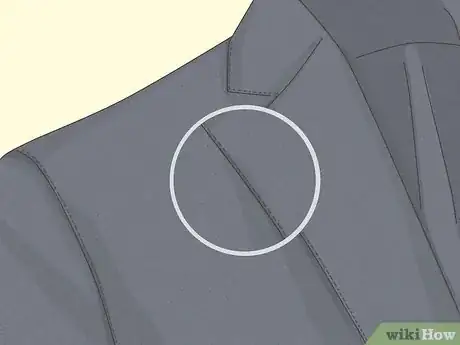This article was co-authored by Hannah Park and by wikiHow staff writer, Hannah Madden. Hannah Park is a professional stylist and personal shopper with experience in e-comm styling, celebrity styling and personal styling. She runs an LA-based styling company, The Styling Agent, where she focuses on understanding each individual she works with, and crafting wardrobes according to their needs.
There are 12 references cited in this article, which can be found at the bottom of the page.
This article has been viewed 20,462 times.
Looking for a suit, but aren’t sure where to start? Suits range in price depending on what you’re looking for, but in general, there are 3 main price brackets you can buy from. Whether this is your first time buying a suit or your fiftieth, we’ll tell you everything you need to know about the average cost of a tailored suit. Read on to step out in style!
Things You Should Know
- Basic suits are usually between $400 and $799. They’re perfect for first-time buyers or one-time events.
- Mid-level suits range from $800 to $1,500. They’re usually made of all natural fabrics and will be custom-made to fit you.
- High-end suits are usually $1,500 and up. They’re often bespoke suits, meaning sewn from scratch, and always use all-natural materials.
Steps
How much should you spend on a decent suit?
-
Experts recommend spending around $500 for a quality suit. The $500 range will give you everything you need in a basic suit: quality stitching, nice fabric, and neutral, versatile colors. It isn’t the cheapest suit you can get, but it’s definitely not the most expensive, either.[1] X Research source
The Basic Suit
-
1Expect to spend $400 to $799 on a basic suit. Basic suits are perfect for almost any occasion: a job interview, a wedding, or even a professional event. Suits in this price range are great to have on-hand at any age, and they’re also the perfect suit to splurge on if you’ve never purchased one before.[2] X Research source
- While most basic suits start at $400, you can often find them on sale for as little as $300.
- Most experts agree that you should buy the best quality suit that you can afford.
-
2Look for a wool / polyester blend suit. Basic suits are usually made of wool, and some are a blend of fabrics, too. Depending on where you purchase from, you may be able to find Italian wool or even English wool available.[3] X Research source
- Wool absorbs moisture and wicks it away, allowing the fabric to “breathe.” Most suits are made of wool because it helps them stay clean longer and last for decades.
- In this price range, the lining of the suit is typically rayon or polyester.
-
3Go for a blue or medium gray suit. Like their name suggests, basic suits typically come in basic colors: blue, gray, and black are very common. If you’d like a more versatile suit, opt for a charcoal gray or a navy blue so you can wear it to multiple occasions.[4] X Research source
- For your first suit, stay away from patterns or pinstripes. Since this suit is supposed to be versatile, you don’t want it to be too flashy.
- You can add pops of color to a neutral-colored suit with your pocket square.
- If you’re going to a funeral, opt for a black suit instead.
-
4Pay a little extra to get your suit tailored. Even the cheapest suit can look great if it fits you well. At most department stores, you can usually pay $20 to $50 more for tailoring so your suit fits you correctly. Have the tailor take your measurements, then try on your suit again once it’s been altered.
- Most basic suits are “off the rack,” meaning they’ve been mass produced to fit general size guidelines. Odds are, an off the rack suit won’t fit perfectly without some alterations.
The Mid-Level Suit
-
1Set aside $800 to $1,500 for a mid-level suit. Around $800 is when suits start becoming more high quality. You can still find some suits off the rack at this point, but oftentimes, they’ll be made-to-measure or bespoke, meaning the suit is custom-made for you.[5] X Research source
- At this price range, you’ll typically be measured before trying on a suit, and you can specify the color, fabric, and lining that you want.
-
2Look for a wool, silk, and linen blend. Suits in this price range don’t contain any synthetic fabrics; instead, they’re typically a mixture of 2 to 3 high-end natural fabrics. Typical suits are a blend of wool, silk, and linen, but you can find 100% wool or 100% linen suits if you’d prefer.[6] X Research source
-
3Aim for a half-canvas lining. The “canvas” is the layer in between the suit and the lining inside. Typically, mid-level suits will have a half-canvas, meaning the liner is only in the top portion of the jacket. The half-canvas helps the suit hold its shape while conforming to your body, which will make it fit much better.[7] X Research source
- At this price point, the canvas is usually glued in rather than sewn in.
-
4Check for high-quality stitching. While most suits are machine-stitched, a suit at this price point should look high quality and almost hand-done. If you notice any imperfections or loose threads, ask to see a different suit, since that one is probably not worth the money.[8] X Research source
- Most suits in this price range are made in countries like Italy or England. However, it depends a lot on where you’re shopping.
-
5Try out a pattern or new color. If this isn’t your first rodeo, it may be time to step up your suit game just a little. Go for a pinstripe or a plaid suit, and check out the fun colors, too. Now’s your chance to buy a suit that will make you stand out, and one that isn’t quite so versatile.[9] X Research source
- Of course, you can always stick to neutral colors, like blue, black, or gray.
-
6Get the suit fitted to your body. At this price range, you can typically expect multiple rounds of fittings to make sure that the suit is tailored to your body. If anything needs to be altered, don’t be afraid to speak up—the tailor wants to make sure you love your suit when you walk out that door.[10] X Research source
- Tailoring a suit in this price range will typically take around 1 to 2 months.
The High-End Suit
-
1Spend $1,500+ for a high-end suit. Once you spend $1,500 or more on a suit, it’s going to be custom-made for you with the highest quality fabrics. Suits like these are for people who want to make a statement, and who aren’t afraid to spend the money to do so.[11] X Research source
- This price range is usually for people who need to wear suits every day for their job. This isn’t necessarily a suit for a one-time event, it’s a suit that can be worn daily.
-
2Get your measurements taken for a bespoke suit. Bespoke suits are totally unique to you: unlike made-to-measure suits, the tailor isn’t working from a pre-made pattern. Instead, they will take your measurements and draft the suit from scratch to fully fit your needs and your body.[12] X Research source
- A bespoke suit often takes upwards of 2 months to complete fully. If you’re looking for a bespoke suit, get the process started sooner rather than later.
-
3Talk to the tailor about your wants and needs. Since this suit is custom-made for you, you can have an in-depth conversation about what you’re looking for in a suit. Tell your tailor about the look and feel of what you want, and where you’ll be wearing your suit. They’ll be able to guide you to the fabric, color, and pattern that you need.[13] X Research source
- They may also have some guidance for you on the style of suit. Single breasted vs. double breasted, shawl lapel vs. notch lapel, and modern fit vs. classic fit are all decisions that you and your tailor can make.
- If you’re going for a double breasted suit, wear something fitted and tailored underneath to avoid looking bulky.
-
4Look for a suit made from natural materials. Like mid-level suits, you’ll never find a high-end suit with a synthetic fabric blend. Instead, go for a suit made from wool, linen, silk, cotten, or some combination of those fabrics.[14] X Research source
-
5Buy a full-canvas suit. The canvas is the material in between the lining and the fabric of your suit. In high-end suits, the canvas typically covers the entirety of the jacket, and it’s sewn, not glued, in.[15] X Research source
- The canvas helps the suit hold its shape and last longer.
-
6Check for high-quality stitching and handmade buttonholes. Most of your suit will still be machine stitched, but in high-end suits, the buttonholes are typically sewn by hand. These hand-sewn buttonholes are sharp and sleek, and they look much more expensive than ones that have been made by a machine.[16] X Research source
- It can take up to 45 minutes for a tailor to hand-sew 1 buttonhole.
Is an expensive suit worth it?
-
Expensive suits are nice, but don’t break the bank trying to buy one. Most experts agree that you should spend what you can afford instead of over-extending yourself for a high-end suit. Basic suits and mid-level suits are still great suits, and no one’s going to judge you if you show up in a $500 suit for a job interview or your first day of work.[17] X Research source
You Might Also Like
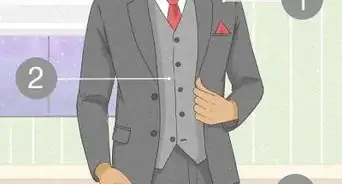 How to Tie the Back of a Waistcoat (with Styling and Fit Tips)
How to Tie the Back of a Waistcoat (with Styling and Fit Tips)
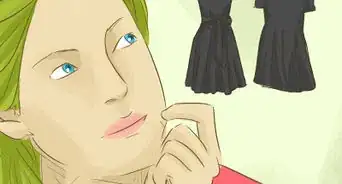

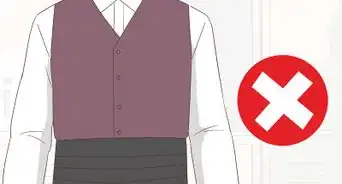
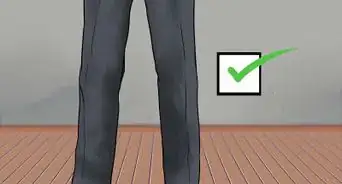
 Here’s What You Should (And Shouldn’t) Wear When Attending a Bar Mitzvah
Here’s What You Should (And Shouldn’t) Wear When Attending a Bar Mitzvah


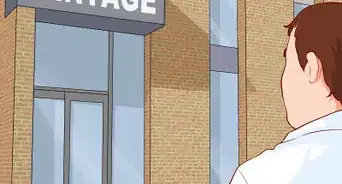
 How to Dress for a Quinceañera as a Guest
How to Dress for a Quinceañera as a Guest




References
- ↑ https://www.businessinsider.com/what-to-consider-when-buying-your-first-suit-2013-8
- ↑ https://www.youtube.com/watch?v=LduxRfSG2qc&t=231s
- ↑ https://www.youtube.com/watch?v=LduxRfSG2qc&t=239s
- ↑ https://www.businessinsider.com/what-to-consider-when-buying-your-first-suit-2013-8
- ↑ https://www.youtube.com/watch?v=LduxRfSG2qc&t=251s
- ↑ https://www.youtube.com/watch?v=LduxRfSG2qc&t=258s
- ↑ https://www.forbes.com/2008/10/31/menswear-perfect-suits-forbeslife-cx_jp_1031style.html?sh=3584faa860d8
- ↑ https://www.forbes.com/2008/10/31/menswear-perfect-suits-forbeslife-cx_jp_1031style.html?sh=3584faa860d8
- ↑ https://www.gq.com/story/why-a-kiton-suit-costs-10k-michiel-huisman
- ↑ https://www.cnn.com/travel/article/top-tailors-tips-suits/index.html
- ↑ https://www.youtube.com/watch?v=LduxRfSG2qc&t=269s
- ↑ https://www.cnn.com/travel/article/top-tailors-tips-suits/index.html
- ↑ https://www.youtube.com/watch?v=8TsWXB2LLFQ&t=115s
- ↑ https://www.forbes.com/2008/10/31/menswear-perfect-suits-forbeslife-cx_jp_1031style.html?sh=3584faa860d8
- ↑ https://www.forbes.com/2008/10/31/menswear-perfect-suits-forbeslife-cx_jp_1031style.html?sh=3584faa860d8
- ↑ https://www.businessinsider.com/how-to-spot-a-high-quality-suit-2014-12
- ↑ https://www.businessinsider.com/what-to-consider-when-buying-your-first-suit-2013-8
- ↑ https://www.youtube.com/watch?v=LduxRfSG2qc&t=281s
About This Article









